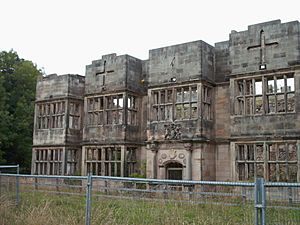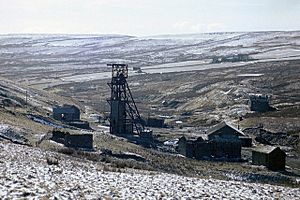Burnopfield facts for kids
Quick facts for kids Burnopfield |
|
|---|---|
| Village | |
| Population | 4,533 |
| OS grid reference | NZ180572 |
| Unitary authority | |
| Ceremonial county | |
| Region | |
| Country | England |
| Sovereign state | United Kingdom |
| Post town | NEWCASTLE UPON TYNE |
| Postcode district | NE16 |
| Dialling code | 01207 |
| Police | Durham |
| Fire | County Durham and Darlington |
| Ambulance | North East |
| EU Parliament | North East England |
| UK Parliament |
|
Burnopfield is a village in County Durham, England. It is located north of Stanley and Annfield Plain. The village is close to the River Derwent. It sits about 564 feet above sea level. Around 4,553 people live in Burnopfield. It is about 7 miles from Newcastle upon Tyne and 15 miles from Durham.
Contents
What's in a Name? (Etymology)
The name Burnopfield likely comes from an old English phrase. It means "field by the valley stream." However, a local story tells a different tale. It says the village got its name during a Scottish invasion attempt. The villagers supposedly burned up the fields to stop the enemy army. In the 1800s, people often called Burnopfield "the Leap." In the local accent, it was "the Loup." This name came from an area called Bryan's Leap.
Burnopfield's Past (History)

Burnopfield was once home to a hospital for people with leprosy. This was called High Friarside Hospice. It was built in 1312 but taken down around 1450. You can still see parts of the original chapel today. Other old buildings in Burnopfield include Burnopfield Hall. The wealthy Newton family, who owned mines, built it in 1720.
Leap Mill Farm is another historic spot. It is a good example of an 18th-century mill. It even has a working water wheel. The Gibside estate is also nearby. It sits between Burnopfield and Rowlands Gill.
Famous Families and a Tricky Marriage
The families of Burnopfield Hall and Gibside are connected through a man named Andrew Robinson Stoney. He was an Irish soldier and adventurer. In the late 1760s, he married Hannah Newton. She was the daughter of the wealthy Newton family. They lived at Colepike Hall. Stoney treated Hannah poorly, and she sadly died a few years later.
Stoney then gained control of her large fortune. He went to London and met the Countess of Strathmore. She owned the Gibside estate. Stoney tricked her into marriage. He had to take her family name, becoming Stoney Bowes. Their unhappy marriage became a very talked-about event of that time. A famous writer, William Makepeace Thackeray, wrote a story inspired by him. This story was later made into a movie called Barry Lyndon.
The family at Gibside Hall later became the Bowes-Lyon family. A famous member of this family was Queen Elizabeth The Queen Mother. Today, the National Trust looks after Gibside Hall. In 1815, the artist J. M. W. Turner painted several pictures of Gibside Hall. You can see them at the Tate Britain museum.
Churches and Faith
In 1746, John Wesley, a famous preacher, visited Burnopfield. He gave a sermon in a garden. He visited many more times, which led to a Methodist Society forming. The first Methodist chapel was built in 1775. It was rebuilt in 1880.
By this time, two more places of worship were built. A second Methodist chapel opened in 1870. In 1873, the Anglican church of Saint James was built. It was located at the Leazes end of the village. Before this church, Burnopfield was part of the Tanfield Anglican Parish.
Coal Mining's Impact
Coal mining started in County Durham in the 1600s. Narrow tracks called waggonways were built from the mines. Burnopfield was a perfect spot for these waggonways. They carried coal from the Pontop and Tanfield Moor areas. The tracks went through Burnopfield, down the hill, and across the River Derwent. From there, the coal went to the River Tyne to be shipped away.
Burnopfield was surrounded by mining villages like Lintz, Hobson, High Friarside, and Marley Hill. However, Burnopfield itself never had a large mine. Over time, many people who lived in Burnopfield worked in the nearby mining villages. In 1889, a Co-operative Society shop was built. This made Burnopfield a shopping center for miners and their families.
As the mining industry in Britain declined, fewer miners lived in the village. They started working in mines closer to the coast. Today, industrial estates, factories, offices, and shops provide jobs for people in Burnopfield. In recent years, the village has grown. New homes have been built, and Burnopfield has spread out. It now includes many nearby areas in its postal district.
Cricket in Burnopfield
Cricket has always been a popular sport in Burnopfield. The village had two small cricket grounds. One is in Lintz, near Burnopfield, and has been there since 1905. The other was once located near Lilac Crescent. Both grounds were given to the clubs by the National Coal Board.
In 2013, a report said that Burnopfield Cricket Club's ground was not good enough. It could not meet the standards needed for the level the club played at. Also, there was no space to improve the field or facilities. Because of this, the old ground was sold for housing. A brand new ground and clubhouse were built about 450 meters to the south-east.
The Burnopfield Club has produced two Test cricketers for England. These players played before Durham County Cricket Club joined the county championship. They were Jim McConnon, who played for Glamorgan, and Colin Milburn. Milburn was known as the "Burnopfield Basher." When Milburn passed away in 1990, his funeral was the largest ever in Burnopfield. Many famous cricket players, including Ian Botham, attended.
Lintz Village
Lintz is a small village located right next to Burnopfield. It is to the south-west. Lintz has its own cricket club.
Famous People from Burnopfield (Notable Residents)
- Eddie Chapman (1914–1997), a secret agent during World War II.
- Jim McConnon (1922–2003), a cricket player for England.
- Colin Milburn (1941–1990), a cricket player for England.
- John Snow (1813–1858), a doctor who helped improve health and safety.
- Dare Wilson (1919–2014), an SAS officer who brought attack helicopters to the British military.
Getting Around (Transport)
The village is served by the Go North East bus company. Current bus services include the 6, which goes from Lanchester to Newcastle. The X71 goes from Consett to Newcastle. After 6 PM, the X72 bus runs from Stanley to Newcastle. The R5 bus runs hourly during the day from Monday to Saturday. It goes from St James Church to Rowlands Gill and Highfield.



